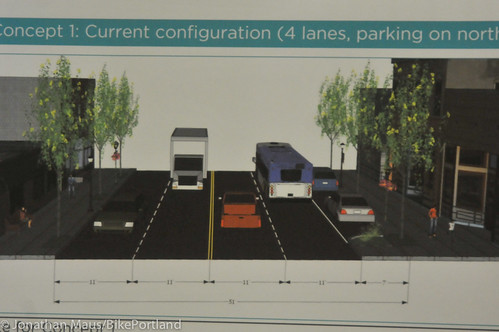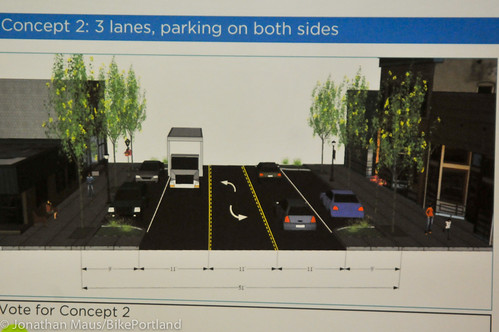
support to improve Lombard Street.
(Photo © J. Maus/BikePortland)
The fact that 100 people showed up to last night’s Lombard Re-Imagined open house, is a clear sign that a group of Portland State University graduate students has spurred an important conversation about the future of Lombard Street. Put together by Swift Planning Group, the open house came after months of meetings, walking tours, design analysis, a neighborhood survey and more.
With a final report due next month, Swift and their neighborhood partners are zeroing in on specific recommendations they hope to get implemented by the City of Portland, the Oregon Department of Transportation, and other local agencies.
Lombard is a classic, auto-centric urban arterial. It’s a state highway, but it also happens to run through dense residential and commercial areas where people live, shop and work. With its high speed traffic and lack of humane design features, the street lacks the social and commercial vibrancy and sense of place that neighborhood residents are clamoring for. Put another way, Project Manager Kathryn Doherty-Chapman wrote via email to me after the open house, “People want places to meet their neighbors, to be able to walk their kids to school and to nearby parks, and to support locally owned businesses. Currently those activities are limited on Lombard, but they don’t have to be.”
Given what I’ve learned from a variety of sources, there appears to be a real chance that Lombard Street — at least between N. Chautauqua and NE Martin Luther King Jr. Blvd — could get a road diet. That is, the street’s current 51-feet wide, four-lane cross-section (with a parking lane on one side) could be altered to just three lanes (one in each direction and a center turn lane) and some combination of auto parking and/or bike lanes.
Here are the three configuration concepts that were shown last night:
Concept 1) Keep the current configuration and improve the parking lane…
Concept 2) Go to three lanes and have a parking lane on both sides…
Concept 3) Go to three lanes and put bike lanes on each side…
It’s important to note that a recent traffic analysis performed by the planning group’s tech research specialist, Jake Warr, showed that reducing one lane of motor vehicle travel on Lombard Street will still allow the street to beat acceptable congestion targets. In other words, PBOT could do this road diet without causing congestion — a key regulatory hurdle any street under consideration for a motor vehicle lane reduction must get over.
“We would love to see bike lanes on Lombard but only if it happens in a way that accommodates existing levels of freight access on that street.”
— Gerik Kransky, BTA Advocacy Director
Another thing to keep in mind is that Lombard is extremely unsafe in its current condition. According to ODOT’s 2009-2011 Safety Priority Index System (SPIS), this stretch of Lombard includes a segment (from N Fenwick to Interstate) that is in the top 5 percent most dangerous roadways in the state as well as several segments in the top 10 percent. I mention that because studies show a clear connection between road diets and improved safety.
At the open house, the public was asked to vote on their preferred concepts. According to Hamilton, concepts two and three received an equal number of votes. Asked about the overall tone of public comment at the open house, Hamilton said, “Lots of people said that changing to 3 lanes and/or other traffic calming methods are the most important changes that could happen.”
As for the bike lane question — it has spurred quite a bit of discussion among planners and the public.
Lombard is a state highway and designated freight route and removing the parking lane isn’t on the table (it’s between seven and nine feet wide in the concepts). With a motor vehicle lane width of 11-feet, that leaves only five feet for the bike lanes — which is a foot narrower than what’s commonly used and recommended in Portland.
“This street has to work. We have to be a city of short trips and this is a very important street if we’re going to make that happen.”
— Roger Geller, PBOT Bicycle Coordinator
Since this is a major freight corridor, the ODOT looms large in the discussions. Tony Coleman, ODOT’s Freight Mobility and Construction Project Liaison, was at the open house. I asked him about the bike lane idea and he seemed open to it; but only if the adjacent motor vehicle lane could be widened to 12 feet. “If they can figure out a 12-foot lane adjacent to the bike lane, we could work with that.”
Coleman said an 11-foot lane directly adjacent to a bike lane is simply too close for comfort for large truck operators. He also told me a story about a company that recently moved a massive ferry hull down Lombard. It was 120 feet long, 16-feet high, and 20.5-feet wide.
Bicycle Transportation Alliance Advocacy Director Gerik Kransky has made collaboration between bike and freight advocates a top priority. He says the BTA would, “love to see bike lanes on Lombard,” but he adds, “only if it happens in a way that accommodates existing levels of freight access on that street.”
Here’s more from Kransky:
“We are committed to finding ways to make big streets safe. On Lombard we may have an opportunity to balance the neighborhood character of the street with the existing freight route designation. In option [concept] three, it seems like a good compromise to have freight’s preferred lane width while providing a safe place for people who ride bikes.”
“We certainly see both sides of this story,” says Rebecca Hamilton of Swift Planning Group, “a direct E-W bike route is needed, but it is hard to imagine the high-traffic Lombard we know today carrying bike traffic with 5-foot lanes. A lot of cyclists said that improved parallel routes were fine and were preferable to a narrow bike lane on a busy street.”
(For what it’s worth, as someone who lives a few blocks from Lombard, I’m not aware of any high-quality parallel routes that can match Lombard for efficient east-west access to major destinations.)
Portland Bureau of Transportation Bicycle Coordinator Roger Geller was also at the open house (he and other PBOT staffers have requested a meeting with Swift Planning Group next week). The Bike Plan for 2030, which Geller helped write, includes Lombard as a designated “city bikeway.” “Given its location and zoning [it’s got a strong commercial zoning designation], this street has to work,” he told me, “We have to be a city of short trips and this is a very important street if we’re going to make that happen.”
Another issue at play in any discussion of bicycling and street re-design in north Portland is how it might impact the character of the neighborhood. Swift’s Doherty-Chapman said they’ve heard from many people who, “don’t want to see Lombard gentrify.” “They don’t want it to turn into a N. Williams. People love their neighborhoods and want to retain the diversity that currently exists, they just want to be able to walk around safely and comfortably, and have places to walk to.”
—
It’s important to note that this project is about much more than lane configurations. The vision for Lombard that Swift plans to create by next month includes ideas for how to develop more vibrant commercial centers, add new streetscape elements, improve dangerous crossings, and so on. Get involved and let them know your thoughts on the Lombard Re-Imagined website and Facebook page.




